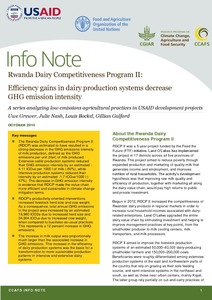Resource information
? The Rwanda Dairy Competitiveness Program II
(RDCP) was estimated to have resulted in a
strong decrease in the GHG emissions intensity
of milk production, defined as the GHG
emissions per unit (liter) of milk produced.
Extensive cattle production systems reduced
their GHG emission intensity by an estimated -
4.11 tCO2e per 1000 l of milk (-60%), while
intensive production systems reduced their
intensity by an estimated -1.7 tCO2e/1000 l (-
47%). The decrease in GHG emission intensity
is evidence that RDCP made the value chain
more efficient and sustainable in climate change
mitigation terms.
? RDCP’s productivity-oriented interventions
increased livestock herd size and cow weight.
As a consequence, total annual GHG emissions
in the project area increased by an estimated
18,980 tCO2e due to increased herd size and
34,904 tCO2e due to increased cow weight,
when compared to business-as-usual practices.
This represents a 12 percent increase in GHG
emissions.
? The increase in milk output was proportionally
much larger than the associated increase in
GHG emissions. This increase in the efficiency
of dairy production systems was the basis for a
transformation to more sustainable production
patterns in intensive and extensive dairy
systems.


